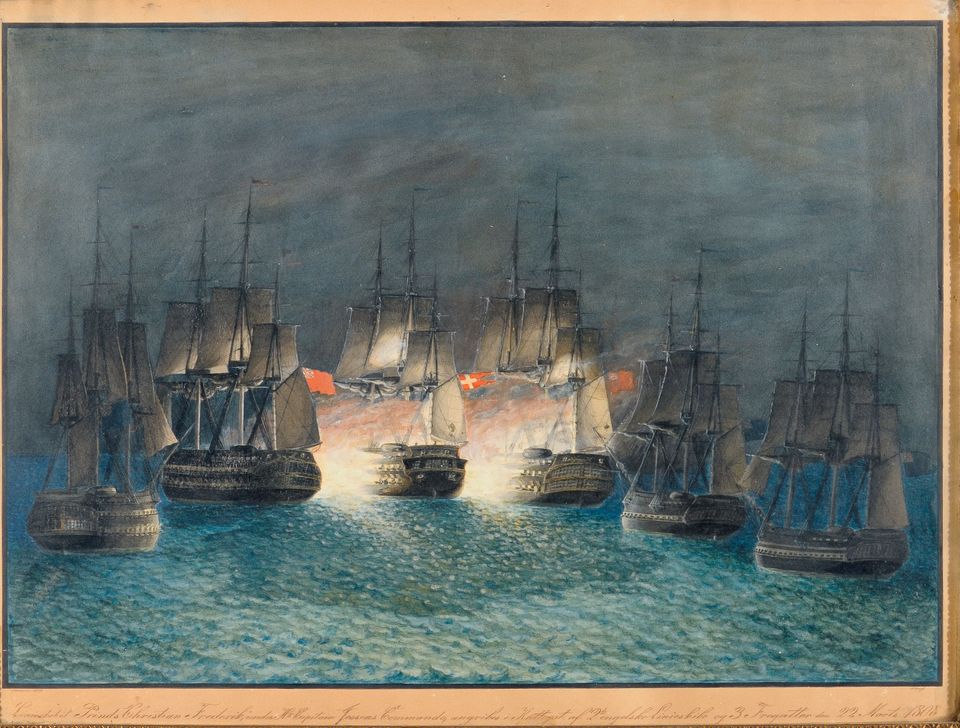HMS Stately (1784) on:
[Wikipedia]
[Google]
[Amazon]
HMS ''Stately'' was a 64-gun
 On 22 March 1808, ''Stately'' and ''Nassau'' destroyed the last Danish ship of the line, , commanded by Captain C. W. Jessen, in the
On 22 March 1808, ''Stately'' and ''Nassau'' destroyed the last Danish ship of the line, , commanded by Captain C. W. Jessen, in the
third-rate
In the rating system of the Royal Navy, a third rate was a ship of the line which from the 1720s mounted between 64 and 80 guns, typically built with two gun decks (thus the related term two-decker). Years of experience proved that the third r ...
ship of the line of the Royal Navy
The Royal Navy (RN) is the United Kingdom's naval warfare force. Although warships were used by English and Scottish kings from the early medieval period, the first major maritime engagements were fought in the Hundred Years' War against ...
, launched on 27 December 1784 at Northam.
French Revolutionary Wars
Sir Richard King took command of ''Stately'' at Portsmouth on 24 July 1793, which was reported in ''The Times'' newspaper. In 1798 ''Stately'' was at the Cape of Good Hope where she was the venue for the court-martial of Mr. Reid, second mate of the East Indiaman . While they were both on shore, Reid had struck Captain Richard Colnett, captain of ''King George'' The court-martial sentenced Reid to two years in theMarshalsea
The Marshalsea (1373–1842) was a notorious prison in Southwark, just south of the River Thames. Although it housed a variety of prisoners, including men accused of crimes at sea and political figures charged with sedition, it became known, ...
prison. Because Colnett had a letter of marque, ''King George'' was a "private man-of-war", and the Navy's Articles of War
The Articles of War are a set of regulations drawn up to govern the conduct of a country's military and naval forces. The first known usage of the phrase is in Robert Monro's 1637 work ''His expedition with the worthy Scot's regiment called Mac- ...
applied at sea. Had Reid struck Colnett aboard ''King George'', the charge would have been mutiny, for which the penalty would have been death.Parkinson (1966; 2013), p.379.
The Admiralty had ''Stately'' converted for use a troopship in 1799. Because ''Stately'' served in the navy's Egyptian campaign (8 March to 2 September 1801), her officers and crew qualified for the clasp "Egypt" to the Naval General Service Medal that the Admiralty
Admiralty most often refers to:
*Admiralty, Hong Kong
*Admiralty (United Kingdom), military department in command of the Royal Navy from 1707 to 1964
*The rank of admiral
*Admiralty law
Admiralty can also refer to:
Buildings
* Admiralty, Traf ...
issued in 1847 to all surviving claimants.
Napoleonic Wars
The Navy reverted her to a fully armed warship once war resumed after the end of theTreaty of Amiens
The Treaty of Amiens (french: la paix d'Amiens, ) temporarily ended hostilities between France and the United Kingdom at the end of the War of the Second Coalition. It marked the end of the French Revolutionary Wars; after a short peace it s ...
.
Battle of Zealand Point
 On 22 March 1808, ''Stately'' and ''Nassau'' destroyed the last Danish ship of the line, , commanded by Captain C. W. Jessen, in the
On 22 March 1808, ''Stately'' and ''Nassau'' destroyed the last Danish ship of the line, , commanded by Captain C. W. Jessen, in the Battle of Zealand Point
The Battle of Zealand Point was a naval battle of the English Wars and the Gunboat War. Ships of the Danish and British navies fought off Zealand Point on 22 March 1808; the battle was a British victory. Peter Willemoes was among the Danish ca ...
.
In 1847 the Admiralty awarded the Naval General Service Medal with clasps "Stately 22 March 1808" and "Nassau 22 March 1808" to any still surviving crew members of those vessels that chose to claim them.
Fate
''Stately'' was broken up in 1814.Notes, citations, and references
Notes Citations References *Lavery, Brian (2003) ''The Ship of the Line - Volume 1: The development of the battlefleet 1650-1850.'' Conway Maritime Press. . *Parkinson, C. Northcote (1966; 2013) ''Trade in Eastern Seas 1793–1813''. (Routledge). Ships of the line of the Royal Navy Ardent-class ships of the line 1784 ships {{UK-line-ship-stub